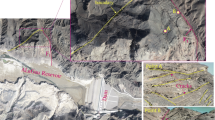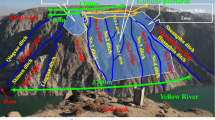Abstract
The instability of continental slopes damages marine engineering equipment, such as submarine pipelines, resulting in the generation of tsunamis, which endangers the safety of nearshore personnel. Therefore, research on the instability of continental slopes where submarine landslides usually occur is crucial to the risk evaluation of deepwater drilling. Previous studies were mainly based on simplified 2D and 3D models, which extend the 2D model applied on submarine slopes with complex topography. In this study, a numerical model with bathymetric data from the Qiongdongnan Basin was established. Furthermore, 3D slope stability analysis and static and dynamic analyses were conducted. The static analysis found two discussions where slopes are most likely to occur. Through the analysis of different seismic forces, the dynamic result showed that an instability area is added to the two positions where the static analysis is unstable. Topography scatters and transmits seismic waves and controls the accumulation and diffusion of seismic energy. 3D calculations and analysis revealed that the direction of slope instability is closely related to terrain inclination, slope, terrain effect, and terrain curvature. Data showed that instability situations could not be derived from a single direction or profile data. Such situations are an important factor in slope stability analysis and are critical to the prediction and evaluation of marine geological disasters.
Similar content being viewed by others
References
Abrams, A. M., 2017. Evaluation of near-surface gases in marine sediments to assess subsurface petroleum gas generation and entrapment. Geosciences, 35(7): 1–29.
Ba, Z., and Yin, X., 2016. Wave scattering of complex local sites in a layered half-space by using a multidomain IBEM: Incident plane SH waves. Geophysical Journal International, 205(3): 1382–1405.
Biscontin, G., Pestana, J. M., and Nadim, F., 2004. Seismic triggering of submarine slides in soft cohesive soil deposits. Marine Geology, 203: 341–354.
Duncan, M. J., 1996. State of the art: Limit equilibrium and finite element analysis of slope. Journal of Geotechnical Engineering, 122(7): 577–595.
Duncan, M. J., 2000. Factors of safety and reliability in geotechnical engineering. Journal of Geotechnical and Geoenvironmental Engineering, 126: 307–316.
Feng, S., Chen, Z., Chen, H., Zheng, Q. T., and Liu, R., 2018. Slope stability of landfills considering leachate recirculation using vertical wells. Engineering Geology, 241: 76–85.
Grilli, S. T., Taylo, O. D., Baxter, C. D. P., and Maretzki, S., 2009. A probabilistic approach for determining submarine landslide tsunami hazard along the upper east coast of the United States. Marine Geology, 264: 74–97.
Hance, J. J., 2003. Development of a database and assessment of seafloor slope stability based on published literature. Master thesis. University of Texas at Austin.
Harris, P. T., Barrie, J. V., Conway, K. W., and Greene, H. G., 2013. Hanging canyons of Haida Gwaii, British Columbia, Canada: Fault control on submarine canyon geomorphology along active continental margins. Deep Sea Research Part II: Topical Studies in Oceanography, 104: 83–92.
He, Y., Zhong, G., Wang, L., and Kuang, Z., 2014. Characteristics and occurrence of submarine canyon-associated landslides in the middle of the northern continental slope, South China Sea. Marine and Petroleum Geology, 57: 546–560.
Heller, V., Bruggemann, M., Spinneken, J., and Rogers, B. D., 2016. Composite modelling of subaerial landslide-tsunamis in different water body geometries and novel insight into slide and wave kinematics. Coastal Engineering, 109: 20–41.
Horozal, S., Bahk, J. J., Urgeles, R., Kim, G. Y., Cukur, D., Kim, S. P., et al., 2017. Mapping gas hydrate and fluid flow indicators and modeling gas hydrate stability zone (GHSZ) in the Ulleung Basin, East (Japan) Sea: Potential linkage between the occurrence of mass failures and gas hydrate dissociation. Marine and Petroleum Geology, 80: 171–191.
Huang, C. Y., Wang, P. X., Yu, M. M., You, C. F., Liu, C. S., Zhao, X. X., et al., 2019. Potential role of strike-slip faults in opening up the South China Sea. National Science Review, 6(5): 891–901.
Jeong, S. W., Locat, J., Leroueil, S., and Robert, J. L., 2013. Fluidization process in submarine landslides: Physical and numerical considerations. Marine Georesources & Geotechnology, 31: 190–207.
Leynaud, D., Mienert, J., and Nadim, F., 2004. Slope stability assessment of the Helland Hansen area offshore the mid-Norwegian margin. Marine Geology, 213: 457–480.
Li, J. B., 2011. Dynamics of the continental margins of South China Sea: Scientific experiments and research progresses. Journal of Geophysics, 54(12): 2993–3003 (in Chinese with English abstract).
Liu, Z., Liang, J., and Huang, Y., 2015. The IBIEM solution to the scattering of plane SV waves around a canyon in saturated poroelastic half-space. Journal of Earthquake Engineering, 19(6): 956–977.
Ma, L., Lu, Y., Wang, L., and Sun, Y., 2016. Study on ground motion characteristics in loess Hill Valley sites. China Earthquake Engineering Journal, 38(3): 373–381 (in Chinese with English abstract).
Ma, Y., Li, S. Z., Liang, J., Suo, Y., Dai, L., Wang, X., et al., 2012. Characteristics and mechanism of submarine landslides in the Qiongdongnan Basin, northern South China Sea. Journal of Jilin University (Earth Science Edition), 42(s3): 196–205 (in Chinese with English abstract).
Masson, D. G., Arzola, R. G., Wynn, R. B., Hunt, J. E., and Weave, P. P. E., 2011. Seismic triggering of landslides and turbidity currents offshore Portugal. Geochemistry Geophysics Geosystems, 12: Q12011.
Masson, D. G., Harbitz, C. B., Wynn, R. B., Pedersen, G., and Lovholt, F., 2006. Submarine landslides: Processes, triggers and hazard prediction. Philosophical Transactions of the Royal Society A-Mathematical Physical and Engineering Sciences, 364: 2009–2039.
Matsui, T., and San, K. C., 1992. Finite element slope stability analysis by shear strength reduction technique. Soils and Foundations, 32(1): 59–70.
Nadim, F., and Kvalstad, T. J., 2007. Risk assessment and management for offshore geohazards. First International Symposium on Geotechnical Safety & Risk. Shanghai, 159–173.
Ouyang, M. T., Wu, T., Li, L., Qiu, Y., and Zhu, Q., 2020. Seabed stability evalution of deep water well site with complex topography in Qiongdongnan continental slope area. China Offshore Oil and Gas, 32(4): 179–189 (in Chinese with English abstract).
Pampell-Manis, A., Horrillo, J., Shigihara, Y., and Parambath, L., 2016. Probabilistic assessment of landslide tsunami hazard for the northern Gulf of Mexico. Journal of Geophysical Research, 121: 1009–1027.
Rahman, M. S., and Jaber, W. Y., 1991. Submarine landslides: Elements of analysis. Marine Georesources & Geotechnology, 10: 97–124.
Rasyif, T. M., Syamside, Al’ala, M., and Fahmi, M., 2016. Numerical simulation of the impacts of reflected tsunami waves on Pulo Raya Island during the 2004 Indian Ocean tsunami. Journal of Coastal Conservation, 20(6): 489–499.
Shi, Y. H., Liang, Q. Y., Yang, J. P., Yuan, Q. M., Wu, X. M., and Kong, L., 2019. Stability analysis of submarine slopes in the area of the test production of gas hydrate in the South China Sea. China Geology, 2: 276–286.
Song, B., Cheng, Y., Yan, C., Lyu, Y., Wei, J., Ding, J., et al., 2019. Seafloor subsidence response and submarine slope stability evaluation in response to hydrate dissociation. Journal of Natural Gas Science and Engineering, 65: 197–211.
Strupler, M., Hilbe, M., Anselmetti, F. S., Kopf, A. J., Fleischmann, T., and Strasser, M., 2017. Probabilistic stability evaluation and seismic triggering scenarios of submerged slopes in Lake Zurich (Switzerland). Geo-Marine Letters, 37: 241–258.
Sultan, N., Cochonat, P., Foucher, J. P., Mienert, J., 2004. Effect of gas hydrates melting on seafloor slope instability. Marine Geology, 213: 379–401.
Sun, Z., Lin, J., Qiu, N., Jian, Z. M., Wang, P. X., Pang, X., et al., 2019. The role of magmatism in the thinning and breakup of the South China Sea continental margin. National Science Review, 6(5): 871–876.
Talling, P. J., Clar, M., Urlaub, M., Pope, E., Hunt, J. E., and Watt, S. F. L., 2014. Large submarine landslides on continental slopes geohazards, methane release, and climate change. Oceanography, 27: 32–45.
Tang, G., Li, F., and Liu, X., 2010. Digital Elevation Model Tutorial. Science Press, Beijing, 256pp.
Terry, J. P., Winspear, N., Goff, J., and Tan, P. H. H., 2017. Past and potential tsunami sources in the South China Sea: A brief synthesis. Earth-Science Reviews, 167: 47–61.
Wang, G., Du, C. Y., Huang, D. R., Jin, F., Roo, R. C. H., and Kwan, J. S. H., 2018. Parametric models for 3D topographic amplification of ground motions considering subsurface soils. Soil Dynamics and Earthquake Engineering, 115: 41–54.
Watts, P., and Grilli, S. T., 2003. Underwater landslide shape, motion, deformation, and tsunami generation. The Thirteenth International Offshore and Polar Engineering Conference. Hawaii, 364.
Wonham, J. P., Jayr, S., Mougamba, R., and Chuilon, P., 2000. 3D sedimentary evolution of a canyon fill (lower Miocene-age) from the Mandorove formation, offshore Gabon. Marine and Petroleum Geology, 17: 175–197.
Wu, P., Hou, D., Gan, J., and Li, X., 2018a. Paleoenvironment and controlling factors of Oligocene source rock in the eastern deepwater area of Qiongdongnan Basin: Evidences from organic geochemistry and palynology. Energy & Fuels, 32(7): 7423–7437.
Wu, S., Wang, D., and David, V., 2018b. Deep-sea geohazards in the South China Sea. Journal of Ocean University of China, 17(1): 1–7.
Xu, W., Che, A., Wang, Z., Wang, H., and Liu, C., 2011. Destruction characteristic of seabed landslide during earthquake motion and its mechanism. Journal of Shanghai Jiaotong University, 45(5): 782–786.
Zhan, W., Liu, Y., Zhong, J., and Lu, C., 1995. Preliminary analysis of the active faults and hazard geology in the south of the South China Sea. Marine Geology & Quaterary Geology, 15(3): 1–9.
Zhan, W., Sun, Z., Zhu, J., Tang, C., and Qiu, X., 2001. A study on geology environment and hazards in Pearl River Mouth Islands and waters. Marine Geology & Quaternary Geology, 21(4): 31–36 (in Chinese with English abstract).
Acknowledgements
This study was supported by the National Key Research and Development Program of China (No. 2019YFC0312 301), and the Nation Natural Science Foundation of China (No. U1701245).
Author information
Authors and Affiliations
Corresponding author
Rights and permissions
About this article
Cite this article
Ma, L., Wu, S., Liu, Y. et al. Slope Instability Analysis of the Qiongdongnan Basin in the Northern Part of the South China Sea: Implications for the Risk Evaluation of Deepwater Drilling. J. Ocean Univ. China 22, 393–409 (2023). https://doi.org/10.1007/s11802-023-4985-y
Received:
Revised:
Accepted:
Published:
Issue Date:
DOI: https://doi.org/10.1007/s11802-023-4985-y




